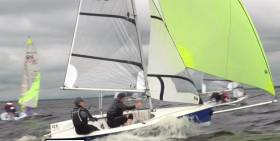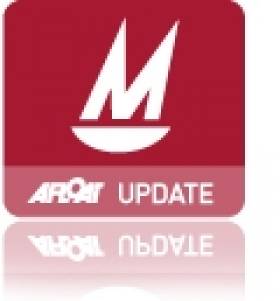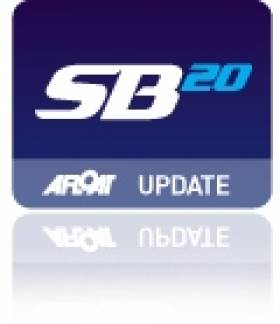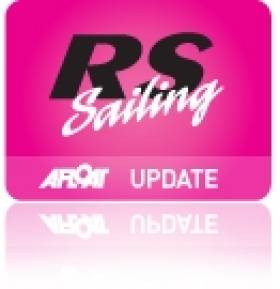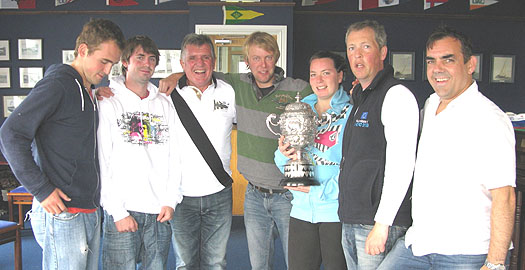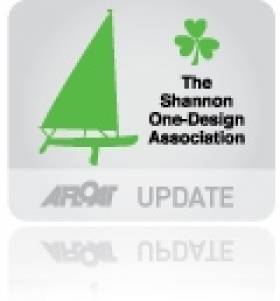Displaying items by tag: Lough Ree Yacht Club
RS200s & RS400 Dinghies Have a Blast At Waterways Ireland 2016 RS Inland Championships
The RS Fleet enjoyed a cracking weekend of racing as Lough Ree Yacht Club played host to the Waterways Ireland 2016 RS Inland Championships last weekend. Race Officer John Leech managed to play the shifty conditions better than most competitors and completed a full programme of six races with winds ranging from sub ten knots to mid-twenties for Sunday’s final blast.
As words don’t do the action justice, check out this video below by Shane Goggin.
Day 1 2016 RS Inland Championships RS400 Video:
Results Summary
RS200’s Top 3
1st Marty O’Leary & Rachel Williamson
2nd Neil Spain & Maeve Spain
3rd Aaron Jones & Rebecca Rock
RS400’s Top 3
1st Alex Barry & Richard Leonard
2nd Gareth Flanagan & David Fletcher
3rd Emmet Ryan & James Ryan
#mirror – The Irish Mirror Dinghy Association's winter training started this weekend in rather tricky weather conditions. 14 hardy sailors headed out on to Lough Ree in gusts of 20 knots on Saturday morning, under the excellent coaching guidance of Olympic 470 sailor and Mirror Sailing Champion, Ger Owens. The fleet were flying their spinnakers and Ger had them sailing some fantastic tight circles to keep warm and blow out those winter cobwebs. After a short break for lunch a couple ventured out, but some fierce 30 knot gusts came in and with a few young crew in the team it was quickly decided to head back to the warmth of Lough Ree Yacht Club for tactics coaching.
Sunday started at 9am rigged and ready to sail with blue skies and calm waters, then it soon picked up to gusts of 20–knots across the lake and just as quickly dropped to back light winds, heavy showers, then an incredibly thick snow blizzard. Those hardy sailors were having a ball out there, but coaching had to be called off due to poor visibility - they couldn't see the coach or the next mark! A return to base for snow ball fights and hot chocolates completed a rather "fluky" weekend.
Lough Ree Yacht Club (LRYC) host the Mirror training every year, offering free shed storage between training weekends and a warm welcome with log fire and wifi for the parents and essential hot pasta for the sailors. A massive thank you has to go to them for their support of the Mirror coaching.
The professional coaching by Ger Owens there each year really helps the Mirror sailors to develop their racing skills and the young sailors look forward to it extending their sailing season. Everyone is welcome and the storage facilities provided by LRYC for the boats makes training more accessible for sailors throughout the country and it less wear on the boats from travelling.
North Shannon Team Wins Powerboat RIB Challenge
#powerboatchallenge – The winning Team of the ISA Powerboat Challenge 2014 at Lough Ree Yacht Club went to North Shannon Powerboat School. The school entered two teams in to the challenge with nick names of "Leitrim" and "Roscommon" and the Roscommon gang came up trumps with a 3.5 point lead on 24th Galway Sea Scouts, who had previously won the past two years. Home team Lough Ree Yacht Club came in at a close third place.
28 entrants in 7 teams were at the ISA National Powerboat Championship at Lough Ree Yacht Club on Saturday 1st November. Teams arrived from Irish Sailing Association clubs and training centres in Roscommon, Galway, Wicklow, Leitrim, Bray to compete against a home team from Lough Ree in a challenge of powerboat safety boat skills. There were no high speed manoeuvres on the agenda for the day, just boat control challenges in circumstances experienced in sailing schools and clubs on a daily basis. All a bit like a driving test afloat, but with a team and against the elements.
Challenges for each team were General Boat Handling, Coming Along Side, Picking Up a Mooring, Right an Inverted Dinghy (with no crew) and Lee Shore Landing. Conditions deteriorated as the day continued, with heavy rain and cold winds adding an extra edge to the tasks for all teams, but spirits didn't dampen though and each team rose the challenge. Judges were not only looking at the skills and techniques of their manoeuvres, but also communication and overall team work, so a helm may have performed a manoeuvre perfectly, but poor team communication would reflect in their total score, because to be a truly competent powerboater you need to communicate well with your crew.
Dennis Dillon was the creator of the Powerboat Challenge in 2009 (originally known as the ISA Rib Challenge) and came down to lend a hand on the day, he commented "What stood out most of all is the involvement of the youth and their dedication in this year's challenge. They had trained and their powerboat control skills were excellent." Each team must have two youths aged between 12 and 17 and they are an integral part of the team working as helm, as well as crew. The overall aim of the challenge is to embody the knowledge of safe use of powerboats to young drivers.
A new award of Best Lady Powerboater was presented this year to Linda Laird of North Shannon Powerboat School (Leitrim) and Best Overall Powerboater was presented to Stan Bradbury of Lough Ree Yacht Club, and the local RNLI, for his exceptional communication, coaching and team work.
Full final results are as follows
North Shannon Powerboat School Team 1 Roscommon 82 points
Galway Sea Scouts 78.5 points
Lough Ree Yacht Club 78 points
Wicklow Sailing Club 76.5 points
North Shannon Powerboat School Team 2 Leitrim 67.5 points
Bray Sailing Club Team 1 67 points
Bray Sailing Club Team 2 64 points
Team Details
|
Wicklow Sailing Club Team |
Lough Ree Yacht Club |
North Shannon Powerboat School |
|||||
|
- Isobel O'Grady |
- Stan Bradbury |
- Julie Garland |
|||||
|
- Ken O'Grady |
- Erica Minluihill |
- Cormac Smith |
|||||
|
- Sam Hennessy |
- Lochlann O'Regan |
- Brian Boland |
|||||
|
- Bobby Bell King |
- Connor Lande |
- Ben Garland |
|||||
|
Team Manager - Kyron O'Grady |
Team Manager - V Rafter |
Team Manager - Will Ellis |
|||||
|
Galway Sea Scouts |
North Shannon Powerboat School |
Bray Sailing Club |
|||||
|
- Ciaran Jordan |
- Linda Laird |
- Garrett Myhal |
|||||
|
- Eamon Murphy |
- Rory Egan |
- Jack Fegan |
|||||
|
- Lauren McCole |
- David Garland |
- Sanne Fennema |
|||||
|
- John McCole |
- Ruairi Morgan |
- Emma Groves |
|||||
|
Team Manager - Alan Delahunty |
Team Manager - Sharon Garland |
Team Manager - Kevin Murphy |
|||||
|
Bray Sailing Club |
|||||||
|
- Matthew Loughran |
|||||||
|
- Jules Kinsellsa |
|||||||
|
- Aifric Murphy |
|||||||
|
- Jack Hannon |
|||||||
|
Team Manager - Martin Darcy |
|||||||
SB20 Midlands Regatta Won By 'Dinghy Supplies' Crew At Lough Ree Yacht Club
#sb20 – On a weekend of glorious late September weather a competitive fleet of 10 SB20's made the journey midland for the championships in the always welcoming environment of Lough Ree Yacht Club.
With the forecast pointing towards no wind on the Sunday race officer Geoff O' Donoghue made the decision to hold 4 races on the Saturday to ensure a full series would be raced.
Race 1 was started in unseasonally warm weather with winds of 10-15 knots. Dinghy Supplies helmed by Darragh Sheridan won the race with Alert Packaging helmed by Justin Burke second and Should Be... helmed by Michael O' Connor third. Race 2 was again won by Dinghy Supplies with Yachtsman.ie helmed by David Taylor second and Should Be... third. The third race completed a hat-trick of wins for Dinghy Supplies with Corona Extra helmed by Graeme Grant second and Yachtsman.ie third. The fourth race became a bit shiftier with places changing regularly Yachtsman.ie sailed well to come through to win with Alert Packaging second and Dinghy Supplies third.
At the end of the first days racing Dinghy Supplies were leading by 3 points from Yachtsman.ie second and Alert Packaging third. The class were treated to the hospitality of Lough Ree Yacht Club on the Saturday Night with a very enjoyable meal and some late night socilaising.
Sunday saw more wind than expected and race officer Geoff O, Donaghue took the fleet out for 2 races in lighter winds. It was going to turn out to be a day that demonstrated that no overall lead is safe within this fleet. Both Dinghy Supplies and Yachtsman.ie were seen as the strong front runners and both contrived to make it all go to the wire. Race 5 saw The Bear helmed by Kieran Dorgan win with Monkey helmed by Keith Cassidy second and Should Be.. third. With both Yachtsman.ie sixth and Dinghy Supplies eight the regatta was open to the last race. Race six saw 2 boats over at the start with Yachtsman.ie going straight back and Dinghy Supplies having to hoist gennaker to go back when their number was called a minute into the race. This led to a tense race in shifty conditions for the overall pace setters. Corona Extra sailed clever and won the race with Monkey capping off a well sailed day in tricky conditions with another second and Should Be.. capping off a consistent series with another third. Dinghy Supplies moved from dead last around the first mark to finish seventh and with Yachtsman.ie finishing sixth this meant it was enough for Dinghy Supplies to clinch the title by a point.
Overall it finished Dinghy Supplies first, Yachtsman.ie second and Should Be.. third. With The Bear winning the silver fleet.
Fireball Duo McCartin & Kinsella Triumph At Lough Ree Yacht Club Nationals
#fireball – Barry McCartin & Conor Kinsella only needed one of the two races sailed yesterday, to win the Irish Fireball National Championships writes Cormac Bradley.
Winning the eighth race of the series meant they could not be beaten and for the ninth race they swapped roles with Conor taking the helm. At the second leeward mark they took their leave of the fleet.
The 1-2-3 overnight finished 1-2-3 in Race 8 which gave Kenny Rumball & Finn Bradley a 1pt advantage over Noel Butler & Stephen Oram.
The last race saw three attempts to get it started, an I Flag and two U Flags being put to use. Rumball & Bradley stormed away (proverbially) to win by a country mile, thus securing 2nd overall. Butler & Oram worked very hard to come back from a poor first beat to record a third place finish behind Neil Colin & Margaret Casey who elevated themselves to 6th overall.
Rumball's win secured 2nd overall with Butler taking 3rd. Team Clancy took 4th overall while Niall McGrotty & Neil Cramer were fifth.
Lough Ree served up a very challenging regatta with predominantly light winds. Race Officer John Leech kept to his promise of turning races around quickly and was responsive to the requests for course modifications from the two fleets. His club colleagues also did their best to make both the Fireball & Wayfarer fleets welcome at what is a great location.
RS Dinghy Fleets Descend on Lough Ree for Western Champs
#rssailing – A whopping 98 RS sailors across the three fleets took part in a glorious if slightly windless Westerns in Lough Ree last weekend, comprising 24 400s, 14 200s and 11 fevas writes Heather King.
Many boats arrived on the Friday night to make the most of the lovely venue for the weekend. Saturday morning we awoke to a glassy lake and as we launched and drifted out a small breeze piped up. All credit due to the PRO Liam Moloney and his team who with infinite patience and much moving of marks managed to get two races away before finally drawing a line under it for the day.
In the 400s it was Alex Barry and Richy Leonard who were overnight leaders with a very consistent 1 and 2 , 2nd overnight were father and son pairing of Christopher and Niall Eames while newcomers Sandy Rimmington and Richy Harrington who had led to both first windward marks needed a bit of time to practise their downwind speed but still ended up third after day one. In the 200s Sarah and Ciara Byrne who had a 2 and a 1 respectively led from Sean Craig and Heather King while newcomers to the Feva fleet Zach and Ben McMullin counted two firsts .
Saturday evening was spent mostly in the bar after a fantastic meal provided by the club before retiring to tents and boats and campervans for the night.
Sunday had promised a little more wind and indeed it looked good early on. Out on the water some early wind shifts followed by a general recall for the 200s made for a lot more mark moving for the tireless mark laying team and it was only the Fevas who got away promptly on the first race. The 200s and 400s followed in due course and just got in a race before the wind died away completely. Have to say if there is a place to be hanging around between races Lough Ree is not a bad place to do it! No one was complaining as we drifted around chatting and assuming that was it for the day. Just as the sailors were beginning to give up, a small breeze began and built to be the best breeze of the weekend and the PRO got us started again promptly for race 4 of the series. There were two general recalls for the 400s in race 5 with Gareth Flanagan, Harrington and Rimmington and Eastern Champ Sean Cleary falling foul of the black flag. As the second race of the day was finishing there was roughly five minutes left to the deadline start time for the last race of the day, and with literally seconds to go the PRO blew the 5 minute for the Fevas signalling the start of sequence.
After 5 races Alex Barry was clear leader in the 400s with a 1,1,2,4 and discarding a 4, followed by Chris Penney and Simon Martin in second with Christopher and Niall Eames taking third.
In the 200s it was Sean Craig and Heather King who took the title with a very close fight behind him which up until the last reach to the finish in the last race looked like it could have been a three way tie for second, third and fourth. Stephen Craig and Conor Foley came out on top of the bunch securing second overall with Roy Van Maanen and Kevin O Rourke in third.
The Fevas saw local brothers Zack and Ben McMullin taking first overall with three firsts and a fourth to count. Second was Alison Dolan and Grainne Young followed by Greg Arrowsmith and Conor Little in third.
All credit to the Race management team for holding their nerve and patience to get in 5 races in such tricky conditions. Many thanks to Lough Ree for a very warm welcome and I am sure it wont be long till we are back there again. Full results below.
#yachtclubs – The antiquity of Irish recreational sailing is beyond dispute, even if arguments arise as to when it started, and whether or not the Royal Cork YC really is the world's oldest club in its descent from the Water Club of the Harbour of Cork from 1720. But all this seems academic when compared with the impression made by relics of Ireland's ancient sailing traditions.
In just six short years, the Royal Cork Yacht Club will be celebrating its Tercentenary. In Ireland, we could use a lot of worthwhile anniversaries these days, and this 300th has to be one of the best. The club is so firmly and happily embedded in its community, its area, its harbour, in Munster, in Ireland and in the world beyond, that it is simply impossible to imagine sailing life without it.
While the Royal Cork is the oldest, it's quite possible it wasn't the first. That was probably something as prosaic as a sort of berth holder's association among the owners of the ornamental pleasure yachts which flourished during the great days of the Dutch civilisation in the 16th and 17th Centuries. They were based in their own purpose-built little harbours along the myriad waterways in or near the flourishing cities of The Netherlands. Any civilisation which could generate delightful bourgeois vanities like Rembrandt's Night Watch, or extravagant lunacies such as the tulip mania, would have had naval-inspired organised sailing for pleasure and simple showing-off as central elements of its waterborne life.
Just sailing for pleasure and relaxation, rather than going unwillingly and arduously afloat in your line of work, seems to have been enough for most. Thus racing – which is the surest way to get some sort of record kept of pioneering activities – was slow to develop, even if inter-yacht matches were held, particularly once the sport had spread to England with the restoration of Charles II in 1660.
Ireland had not the wealth and style of either Holland or England, but it had lots of water, and it was in the very watery Fermanagh region that our first hints of leisure sailing appeared. It's said of Fermanagh that for six months of the year, the lakes are in Fermanagh, and for the other six, Fermanagh is in the lakes. Whatever, the best way to get around the Erne's complex waterways system, which dominates Fermanagh and neighbouring counties, was by boat. By the 16th Century Hugh Maguire, the chief of the Maguires, aka The Maguire, had a Lough Erne-based fleet, some boats of which were definitely for ceremonial and recreational use.
Sport plays such a central - indeed total - role in Irish life that it's highly likely these pleasure sailing boats were sometimes used for racing. However, the first recorded race anywhere in Ireland took place in Dublin Bay in 1663 when the polymath Sir William Petty, having built his pioneering catamaran Simon & Jude, then organised a race with a Dutch sailing vessel and a local "pleasure boatte" of noted high performance. This event, re-sailed in 1981 when the indefatigable Hal Sisk organised the building of a re-creation of the Simon & Jude, resulted both times in victory for the new catamaran. But because a larger sea-going version of the Simon & Jude, called The Experiment at the suggestion of Charles II himself, was later to founder with all hands while on a testing voyage in the Bay of Biscay, the multi-hull notion was abandoned in Europe for at least another two centuries.
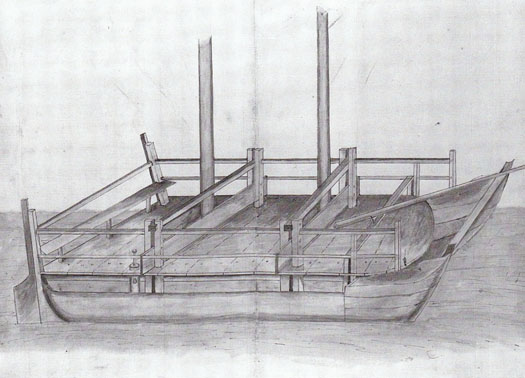
Contemporary drawing of the 17th Century catamaran Simon & Jude, which was built in Dublin and tested in the bay in an early "yacht race" in 1663.
We meanwhile are left wondering just what was this "pleasure boatte" was, and who owned and sailed it. Its existence and good sailing performance seems to have been accepted as unremarkable in Dublin Bay, yet no other record or mention of it has survived.
It was the turbulent life of Munster in the 17th Century which eventually created the conditions in which the first yacht club was finally formed. As the English Civil War spread to Ireland at mid-Century with a mixture of internecine struggle and conquest, the Irish campaigner Murrough O'Brien, the Sixth Baron Inchiquin, changed sides more than once, but made life disagreeable and dangerous for his opponents whatever happened to be the O'Brien side for the day.
Yet when the forces supporting Charles II got back on top in 1660 after the death of Cromwell in 1658, O'Brien was on the winning side. As the dust settled and the blood was washed away, he emerged as the newly-elevated Earl of Inchiquin, his seat at Rostellan Castle on the eastern end of Cork's magnificent natural harbour, and his interests including a taste for yachting acquired with his new VBF Charles II.
But there was much turmoil yet to come with the Williamite wars in Ireland at the end of the 17th Century. Yet somehow as the tide of conflict receded, there seemed to be more pleasure boats about Cork Harbour than anywhere else, and gradually their activities acquired a level of co-ordination. The first Earl of Inchiquin had understandably kept a fairly low profile once he got himself installed in his castle, but his descendants started getting out a bit and savouring the sea. So when the Water Club came into being in 1720, the fourth Earl of Inchiquin was the first Admiral.
In the spirit of the times, having an aristocrat as top man was sound thinking, but this was truly a club with most members described as "commoners", even if there was nothing common about their exceptional wealth and their vast land-holdings in the Cork Harbour area. Much of it was still most easily reached by boat, thus sailing passenger vessels and the new fancy yachts interacted dynamically to improve the performance of both.
Yet there was no racing. Rather, there was highly-organised Admiral Sailing in formation, something which required an advanced level of skill. However, many of the famous club rules still have a resonance today which gives the Water Club a sort of timeless modernity, and bears out the assertion by some historians that, as it all sprang to life so fully formed, the formation date of 1720 must be notional, as all the signs are that there had been a club of some sort for years beforehand.
But either way, it makes no difference to the validity or otherwise of the rival claim, that the Squadron of the Neva at St Petersburg in Russia, instituted by the Czar Peter the Great in 1718 to inculcate an enthusiasm for recreational sailing among Imperial Russia's young aristocrats, was the world's first yacht club. It was no such thing. It was in reality a unit of the Russian navy, and imposed by diktat from the all-powerful ruler. As such, it was entirely lacking the basic elements of a true club, which is a mutual organisation formed by and among equals.
Yet as the Water Club of the Harbour of Cork had no racing with results published in what then passed for the national media, we are reliant on the few existing club records and some travel writing from the time for much of our knowledge of the early days of the Water Club. That, and the Peter Monamy paintings of the Water Club fleet at sea in 1738.
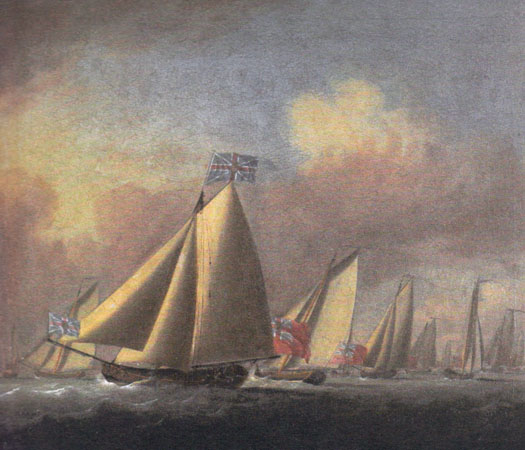
A remarkably well-disciplined fleet. Peter Monamy's 1738 painting of the yachts of the Water Club at sea off Cork Harbour. They weren't racing, but were keeping station in carefully-controlled "Admiral Sailing". Courtesy RCYC
Fortunate indeed are the sailors of Cork, that their predecessors' activities should have been so superbly recorded in these masterpieces of maritime art. The boats may look old-fashioned to a casual observer, yet there's something modern or perhaps timeless in this depiction of the fleet sailing in skilled close formation, and pointing remarkably high for gaff rigged boats as they turn to windward. Only a genuine shared enthusiasm for sailing could have resulted in such fleet precision, and in its turn in a memorable work of art. It is so much part of Irish sailing heritage that we might take it for granted, but it merits detailed study and admiration no matter how many times you've seen it already.
Shortly after Monamy's two paintings were completed, Ireland entered a period of freakish weather between 1739 and 1741 when the sun never shone, yet it seldom if ever rained, and it was exceptionally cold both winter and summer. It is estimated that, proportionately speaking, more people died in this little known famine than in the Great Famine itself 104 years later. While the members of the Water Club would have been personally insulated from the worst of it, the economic recession which struck an intensely agricultural area like Cork affected all levels of society.
Thus the old Water Club saw a reduction in activity, but though it revived by the late 1740s, the sheer energy and personal commitment of its early days was difficult to recapture, and by the 1760s it was becoming a shadow of its former self. Nevertheless there was a revival in 1765 and another artist, Nathanael Grogan, produced a noted painting of Tivoli across from Blackrock in the upper harbour, with a yacht of the Water Club getting under way for a day's recreation afloat, the imminent departure being signalled by the firing of a gun.
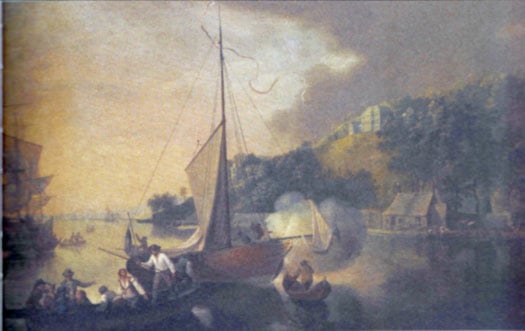
The best way to get the crew on board....on upper Cork Harbour at Tivoli in 1765, a yacht of the reviving Water Club fires a gun to signal imminent departure.
However, it was on Ireland's inland waterways that the next club appeared – Lough Ree Yacht Club came into being in 1770, and is still going strong. That same year, one of the earliest yacht clubs in England appeared at Starcross in Devon, but it was in London that the development pace was being most actively set with racing in the Thames for the Cumberland Fleet. Some members of this group, after the usual arguments and splits which plague any innovative organisation, in due course re-formed themselves as the Royal Thames Yacht Club in the early 1800s. But the famous yet unattributed painting of the Cumberland Fleet racing on the Thames in 1782, while it is slightly reminiscent of Monamy's painting of the Water Club 44 years earlier, undoubtedly shows boats racing. And they'd rules too – note the port tack boat on the right of the picture bearing off to give way to the boat on starboard.
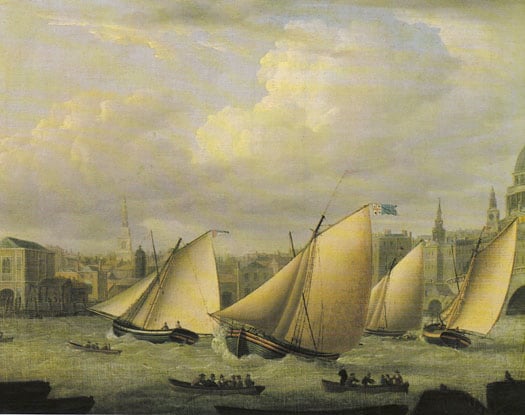
Definitely racing – the Cumberland Fleet, precursor of the Royal Thames Yacht Club, racing in the River Thames at Blackfriars in 1782.
The Thames was wider in those days, but even so they needed strict rules to make racing possible. Dublin Bay offered more immediate access to open water, and there were certainly sailing pleasure boats about. When the Viceroy officially opened the Grand Canal Dock on April 23rd 1796, it was reported that the Viceregal yacht Dorset was accompanied by a fleet of about twenty ceremonial barges and yachts. Tantalisingly, the official painting is almost entirely focused on the Dorset and her tender, while the craft in the background seem to be naval vessels or revenue cutters.
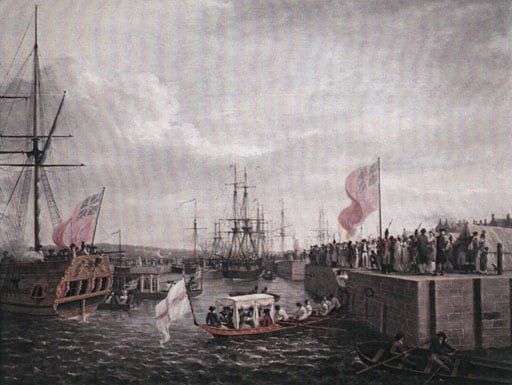
This painting of the opening of the Grand Canal Dock in 1796 tends to concentrate on the ceremonials around the Viceroy's yacht Dorset in the foreground, but fails to show clearly any of the several privately-owned yachts which were reportedly also present....
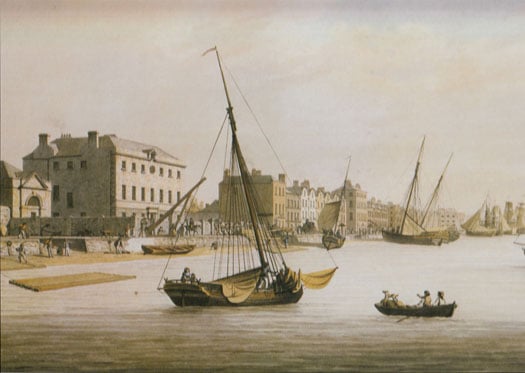
.......but this illustration of the old Marine School on the South Quays in Dublin in 1803 seems to have a yacht – complete with owner and his pet dog on the dinghy in the foreground – anchored at mid-river.
However, a Malton print of the Liffey in 1803 shows clearly what is surely a yacht, the light-hearted atmosphere of waterborne recreation being emphasised by the alert little terrier on the stern of the tender conveying its owner in the foreground Meanwhile in the north of Ireland there was plenty of sailing space in Belfast Lough, while Belfast was a centre of all sorts of innovation and advanced thinking. Henry Joy McCracken, executed for his role in the United Irishmen's rising in 1798, was a keen pioneer yachtsman. As things took a new turn of determined money-making in Belfast after the Act of Union of 1801, some of his former crewmates were among those who formed the Northern Yacht Club in 1824, though it later transferred its activities across the North Channel to the Firth of Clyde, and still exists as the Royal Northern & Clyde YC.
Meanwhile in 1806 the old Water Club of the Harbour of Cork had shown new signs of life, but one result of this was an eventual agreement among members - some of them very old indeed, some representing new blood - that the club would have to be re-structured and possibly even given a new name in order to reflect fresh developments in the sport of yachting. The changeover was a slow business, as it had to honour the club's history while giving the organisation contemporary relevance. Thus it was 1828 before the Royal Cork Yacht Club had emerged in this fully fledged new form, universally acknowledged as the continuation of the Water Club, and incorporating much of its style.
But it was across the north on Lough Erne in 1820 that the world's first yacht club specifically set up to organise racing was formed, and Lough Erne YC continues to prosper today, its alumnae since 1820 including early Olympic sailing medallists and other international champions.
There must have been something in the air in this northwest corner of Ireland in the 1820s, for in 1822 the men who sailed and raced boats on Lough Gill at Sligo had a pleasant surprise. Their womenfolk got together and raised a subscription for a handsome silver trophy to be known as the Ladies' Cup, to be raced for annually – and it still is.
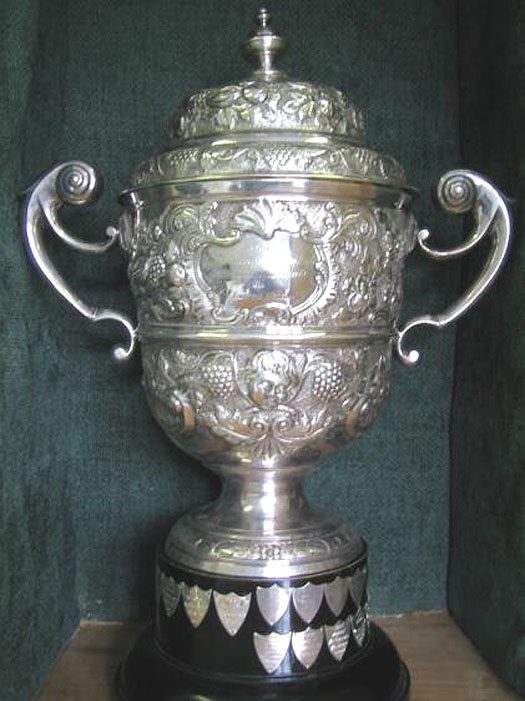
Instituted in 1822, the Ladies' Cup of Sligo YC is the world's oldest continually-contested annual sailing trophy.
Annual challenge cups now seem such a natural and central part of the sailing programme everywhere that it seems extraordinary that a group of enthusiastic wives, sisters, mothers and girlfriend in northwest Ireland were the first to think of it, yet such is the case. Or at least theirs is the one that has survived for 192 years, so its Bicentenary in 2022 is going to be something very special.
Those racing pioneers of the Cumberland Fleet had made do with new trophies freshly presented each year. And apparently the same was the case initially at Lough Erne. But not so very far down the road, at Sligo, somebody had this bright idea which today means that the museum in Sligo houses the world's oldest continually raced-for sailing trophy, and once a year it is taken down the road to the Sligo YC clubhouse at Rosses Point to be awarded to the latest winner – in 2013, it was the ever-enthusiastic Martin Reilly with his Half Tonner Harmony.
The Ladies Cup was won in 2013 by Martin Reilly's Half Tonner Harmony. Pictured with their extremely historic trophy are (left to right) Callum McLoughlin, Mark Armstrong, Martin Reilly, John Chambers, Elaine Farrell, Brian Raftery and Gilbert Henry
However, although the Ladies' Cup may have pioneered a worthwhile trend in yacht racing, it wasn't until 1831 that they thought of inscribing the name of the winner, and that honour goes to Owen Wynne of Hazelwood on the shores of Lough Gill. But by that time the notion of inscribing the winners was general for all trophies, and a noted piece of the collection in the Royal Cork is the Cork Harbour Regatta Cup 1829, and on it is inscribed the once-only winner, Caulfield Beamish's cutter Little Paddy.
The name of noted owner, skipper and amateur yacht designer Caulfield Beamish came up here some time back, when we were discussing how in 1831 he took a larger new yacht to his own design, the Paddy from Cork, to Belfast Lough where he won a stormy regatta. So you begin to understand the mysterious enthusiasm people have for sacred relics when you see this cup with its inscription, and realise that it's beyond all doubt that this now-forgotten yet brilliant pioneer of Cork Harbour sailing development personally held this piece of silverware.
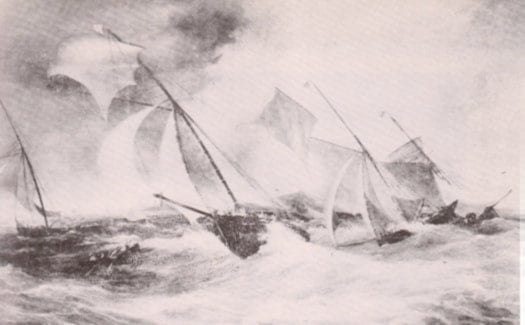
Caulfield Beamish's new cutter Paddy from Cork (which he designed himself) winning a stormy regatta in Belfast Lough in 1831
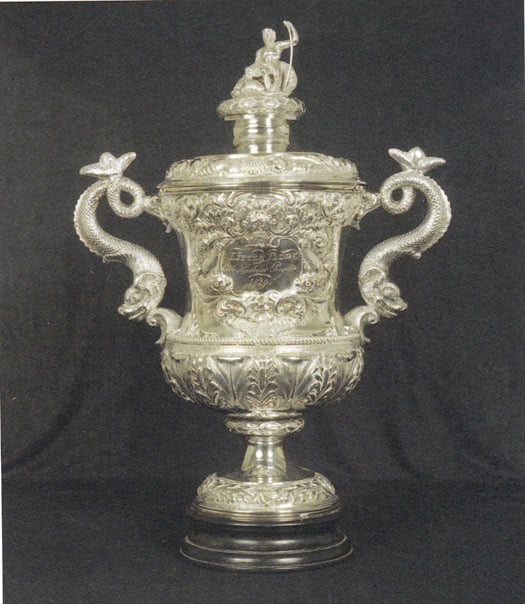
The Cork Harbour Regatta Cup of 1829.....Courtesy RCYC
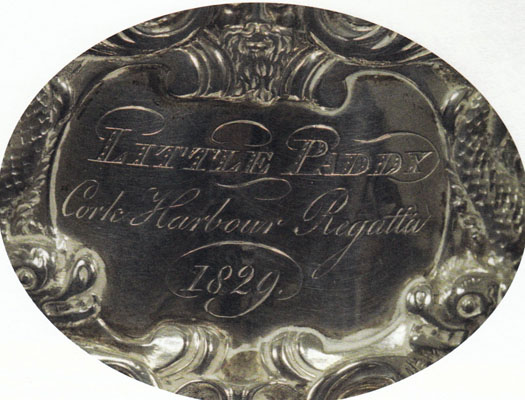
....and on it is inscribed the winner, Caulfield Beamish's earlier boat, Little Paddy, which he also designed himself. Courtesy RCYC
Another pioneer in yacht racing at the time was the Knight of Glin from the Shannon Estuary, who in 1834 was winning all about him with his cutter Rienvelle, his season's haul including a silver plate from a regatta in Galway Bay – it's now in Glin Castle – while he also seems to have relieved fellow Limerick owner William Piercy of £50 for a match race in Cork Harbour against the latter's cutter Paul Pry.
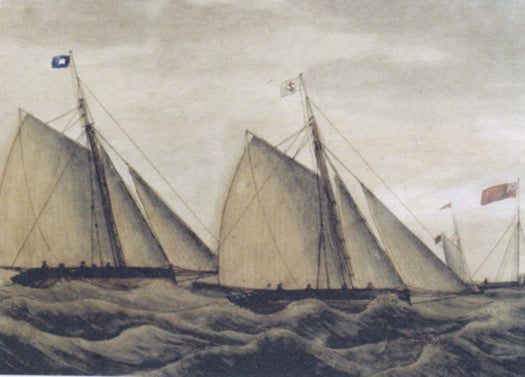
The lads from Limerick hit Cork. William Piercy's Paul Pry racing for a wager of £50 against the Knight of Glin's Rienvelle in Cork Harbour in 1834. When Paul Pry won Cork Harbour Regatta a few weeks later, the band on the Cobh waterfront played Garryowen. Courtesy RCYC
But of all the fabulous trophies in the Royal Cork collection, the one which surely engenders the most affection is the Kinsale Kettle. It goes back "only" to 1859, when it was originally the trophy put up for Kinsale Harbour Regatta. But this extraordinarily ornate piece of silverware was not only the trophy for an annual race, it was also the record of each race, as it's inscribed with brief accounts of the outcomes of those distant contests.
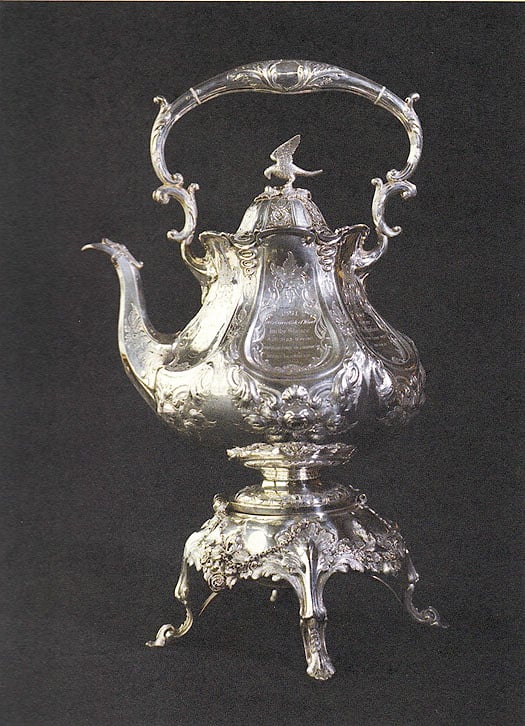
An extraordinary piece of Victorian silverware. The "Kinsale Kettle" from 1859 is now the Royal Cork YC's premier trophy.
Today, it continues to thrive as the Royal Cork Cup, the premier award for Cork Week. The most recent winner in 2012 was Piet Vroon with his superb and always enthusiastic Tonnere de Breskens. The fact that this splendid ambassador for Dutch sailing should be playing such a central role in current events afloat here in Ireland brings the story of our sport's artworks and historical artefacts to a very satisfactory and complete circle.
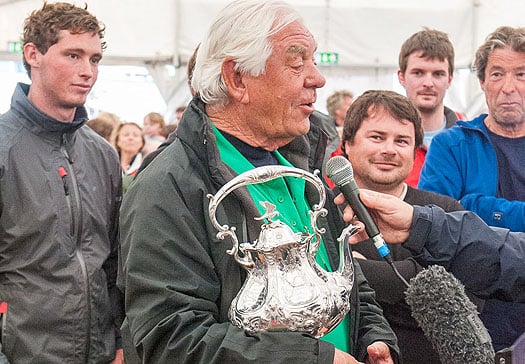
More tea, skipper? The current holder of the Kinsale Kettle, aka the Royal Cork Cup, is Piet Vroon of Tonnere de Breskens. Photo: Bob Bateman
Butlers Lead Fireball Munsters at Lough Ree Yacht Club
16 Fireballs have assembled in Lough Ree Yacht Club (LRYC) for the penultimate regatta of the season, the Munsters. Four excellent Olympic courses were set by Race Officer John Leech and race wins were shared by Noel Butler & Ed Butler (Jnr) 15061 and Barry McCartin & Conor Kinsella 15093. Team Butler added a 2, 3 to the two wins to open up a 2pt lead at the top of the ranking. McCartin/Kinsella had a 4, 5 to be 3pts ahead of Conor Clancy & Stephen Campion (2, 2, 5, 5) giving them a 1pt cushion over Team Rumball, Kenneth & Alexander. In 5th place are Louis Smyth & Cormac Bradley (3, 3, 6, 10).
Other notable individual race results include a third in Race 3 for Louise McKenna & Hermine O'Keeffe and a 4th in Race 4 for Frank Miller & Grattan Donnelly. Mike Murphy & Alex Voye are counting 2x6ths. Jon Evans & Aidan Caulfield had a 7 & 6 in the first two races.
Conditions were good despite a forecast of light easterlies, with trapezing conditions prevalent. Race turnarounds were kept to a minimum which meant that the session on the water was virtually entirely spent racing.
A further two races are scheduled for tomorrow.
Butler & Butler (1, 1, 2, 3) 4pts
McCartin & Kinsella (5, 4, 1, 1) 6pts
Clancy & Campion (2, 2, 5, 5) 9pts
Rumball & Rumball (4, 7, 4, 2) 10pts
Smyth & Bradley (3, 3, 6, 10) 12pts
#shannononedesign – Lough Ree Yacht Club, the recent hosts of the Round Ireland on the inside race and more recent Laser Connaughts, held a special regatta at the weekend (27th-28th July) to celebrate the 50th Anniversary of a remarkable river boat the 'M.V. Harklow' which was designed and built by the renowned Arklow boatbuilder Jack Tyrell for the international yachtsman Douglas Heard, the first President of the Irish Dinghy Racing Association and Commodore of the Royal St. George Yacht Club. The regatta was ably organised by her present owner Dan O'Connor.
A fleet of 18 Shannon-One-Designs competed in the warm summer conditions. In race one, the force 2 wind was from the south east, but quickly backed to the north east causing difficulty to the OOD who had laid the course close too close to the Yellow Islands. There were no opportunities for overtaking. The winner was Frank Browne/Julie Delany/crew in No. 86 followed by Owen/Mags/ Margaret Delany in No. 37 and. Mark McCormick/ crew in No. 50. It was already looking like a regatta in which the older boats might dominate.
The second race, held after lunch, in the open lake with the windward mark close to Little Yellow Island in slightly steadier conditions, was won by Rory Walsh/crew in the beautifully prepared No. 170 from 50 and 86 third.
The third race with a handicap start was started off the yacht Club pontoons was won convincingly by Cathy MacAleavey/Philip Dilworth/crew in the newest boat competing, No.178, but this race was subsequently declared null and void by the protest committee under the careful eye of David Beatty, after one crew protested the entire fleet for sailing the wrong course.
This was followed by a dinner for the competitors and their friends when the Harklow cake was formally cut by Ruth Heard and her daughter Professor Hilary Biehler Delany, followed by Dr. Harmon Murtagh who gave an informative talk on the significance of the M.V. Harklow and her owners. 'The Nuts' a musical group managed by the regatta organiser bashed out 1960's music for the rest of the night to the delight of those who wanted to dance.
On Sunday, after the protest was heard, the first race was held close to Beam Island in a light shifty wind and thundery conditions. Initially Commodore Alan Algeo/DJ/Crew lead the first lap of the race, but on the second beat the shifty wind foiled them, and allowed No. 176 sailed by Harmon Murtagh/Harmon Jnr/crew to win, from Eoin Carrol/ crew in No. 60 and Graham McMullin and family in No. 151.
The second race was held back to back in a wind which was shifting back and forth by up to 80degrees. Thunder and lightning was showing its anger on all sides of the course. It was won by Ian Croxon / crew in No. 56 from No.60 and No. 170. These boats were fortunate to finish before the stair-rods arrived. And about 25mm of rain fell in half an hour. Due to the warm conditions many of the crews were not wearing heavy rain gear and were soaked.
For full race results download the attached xcel file below.
#laser – Almost 100 Lasers enjoyed extraordinary sailing conditions on glorious Lough Ree. FULL RESULTS DOWLOADABLE BELOW. Temperatures over 30 degrees, sailing in rash vest only and shifty F 2-4 were the order of the day. The event combined the Connaught Championships and Irish Laser Youth Championships for all three rigs. The fleet was under the stewardship of International Race Officer Con Murphy who made light work of the tricky conditions.
In the full rigs, a 25 boat fleet had very close racing. In the end, Chris Penney followed up his Leinsters win by running away with it on Sunday following 3 straight wins, an impressive performance on such a streaky and shifty race track. Conor Byrne and Paul MacMahon completed the podium and were always pushing Penney hard. Irish Full Rig youth Champion for 2013 is Cian Cahill from RstGYC/RCYC who rose through the ranks to finish an impressive 5th overall on his first outing with the big sail. Sean Craig took top Master overall.
As usual, the biggest fleet was the Radials. Seafra Guilfoyle, honed from some good international performances recently, had a brief wobble with a black flag Saturday, but a string of bullets gave him both the Connaught and Irish Youth Laser titles. Cian Byrne was comfortable in second and always there or thereabouts while recent winner at Wexford Ryan Glynn emerged from the pack to claim third overall. Erica Ruigrok was first girl overall. The competition in this fleet is incredible these days and it was fantastic to see Annalise Murphy taking time out to sail the first three races, before jetting out to Rio for a few weeks. It was a huge boost to the regatta and the club and campsite were alive Saturday night with tales of "I lee-bow tacked Annalise", "I beat Annalise to the top mark", etc, etc !!! To put the standard of this fleet in perspective, Annalise found herself outside the top ten overall after the first day's racing.
The smaller rig had a fantastic regatta too with almost 20 boats and great conditions for a number of newcomers. Cliodhna O'Regan continued her recent fine form with another overall win to take the Connaught and Youth crowns, with the fast improving Dougie Elmes (Optimist National Champion 2012) taking runner-up.
The Laser action is building up to an exciting peak later next month. On Aug 22-25 RCYC hosts the Vodafone Irish Nationals and then the Laser Europeans/Worlds takes place in Dun Laoghaire Aug 30-Sep 6.
Indeed the organisers for the big international event are appealing for private charter boats amid very tight supply for visiting sailors who, in a big boost for the regatta, will include the famous Robert Scheidt from Brazil. Go to the event website above, to "Racing", "Boat Charter" and top rates of up to € 500 can be your's if you offer up your boat for charter.



























